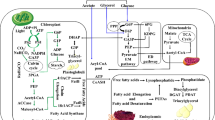Abstract
Two cultivation steps were used for production of biomass and ectoine by Halomonas boliviensis, respectively. The optimization of some nutrient parameters in each step was investigated by using response surface methodology. Twenty and 12 experiments were performed to attain optimal conditions for biomass and ectoine production, respectively. The model predicted a maximum biomass concentration of 3.34 g/L on optimization of NH4Cl, K2HPO4, and MgSO4•7H2O concentrations during the first cultivation, while a maximum ectoine concentration of 1.27 g/L was predicted on optimizing NaCl and monosodium glutamate concentrations in the second cultivation. The experimental values obtained (3.36 g biomass/L and 1.25 g ectoine/L) were in good agreement with the predicted values. The optimized conditions were also used for two-step 1.5-L fed-batch fermentations. In the first step, biomass concentration of 28.7 g/L was obtained while in the second step biomass concentration increased to 63 g/L. Ectoine concentration of 9.2 g/L was obtained, and the overall ectoine productivity was 6.3 g/L/day, being among the highest reported so far.



Similar content being viewed by others
References
Bali U (2004) Application of Box–Wilson experimental design method for the photodegradation of textile dyestuff with UV/H2O2 process. Dyes Pigm 60:187–195
Barrington S, Kim JW (2008) Response surface optimization of medium components for citric acid production by Aspergillus niger NRRL 567 grown in peat moss. Bioresource Technol 99:368–377
Box GEP, Wilson KB (1951) On the experimental attainment of optimum condition. J Royal Stat Soc B13:1–45
Frings E, Sauer T, Galinski EA (1995) Production of hydroxyectoine: high cell-density cultivation and osmotic downshock of Marinococcus strain M52. J Biotechnol 43:53–61
Galinski EA (1993) Compatible solutes of halophilic eubacteria: molecular principles, water-solute interaction, stress protection. Experientia 49:487–496
Galinski EA, Trüper HG (1994) Microbial behaviour in salt-stressed ecosystems. FEMS Microbiol Rev 15:95–108
Guzmán H, Van-Thuoc D, Martín J, Hatti-Kaul R, Quillaguamán J (2009) A process for the production of ectoine and poly(3-hydroxybutyrate) by Halomonas boliviensis. Appl Microbiol Biotechnol 84:1069–1077
Huang X, Lu Z, Bie X, Lü FX, Zhao H, Yang S (2007) Optimization of inactivation of endospores of Bacillus cereus by antimicrobial lipopeptides from Bacillus subtilis fmbj strains using a response surface method. Appl Microbiol Biotechnol 74:454–461
Kunte HJ, Galinski EA, Trüper HG (1993) A modified FMOC-method for the detection of amino acid type osmolytes and tetrahydropyrimidines (ectoines). J Microbiol Meth 17:129–136
Lentzen G, Schwarz T (2006) Extremolytes: natural compounds from extremophiles for versatile applications. Appl Microbiol Biotechnol 72:623–634
Lippert K, Galinski EA (1992) Enzyme stabilization by ectoine-type compatible solutes: protection against heating, freezing and drying. Appl Microbiol Biotechnol 37:61–65
Louis P, Trüper HG, Galinski EA (1994) Survival of Escherichia coli during drying and storage in the presence of compatible solutes. Appl Microbiol Biotechnol 41:684–688
Montgomery DC (2001) Design and analysis of experiments, 5th ed. Wiley, New York
Onraedt AE, Walcarius BA, Soetaert WK, Vandamme EJ (2005) Optimization of ectoine synthesis through fed-batch fermentation of Brevibacterium epidermis. Biotechnol Prog 21:1206–1212
Oren A (2002) Diversity of halophilic microorganisms: environments, phylogeny, physiology, and applications. J Ind Microbiol Biotechnol 28:56–63
Oren A (2008) Microbial life at high salt concentrations: phylogenetic and metabolic diversity. Saline Systems 4:2. doi:10.1186/1746-1448-4-2
Quillaguamán J, Hatti-Kaul R, Mattiasson B, Alvarez MT, Delgado O (2004) Halomonas boliviensis sp. nov., an alkalitolerant, moderate halophile isolated from soil around a Bolivian hypersaline lake. Int J Syst Evol Microbiol 54:721–725
Quillaguamán J, Delgado O, Mattiasson B, Hatti-Kaul R (2006) Poly(β-hydroxybutyrate) production by a moderate halophile, Halomonas boliviensis LC1. Enz Microb Technol 38:148–154
Quillaguamán J, Muñoz M, Mattiasson B, Hatti-Kaul R (2007) Optimizing conditions for poly(β-hydroxybutyrate) production by Halomonas boliviensis LC1 in batch culture with sucrose as carbon source. Appl Microbiol Biotechnol 74:981–986
Quillaguamán J, Doan-Van T, Guzmán H, Guzmán D, Martín J, Everest A, Hatti-Kaul R (2008) Poly(3-hydroxybutyrate) production by Halomonas boliviensis in fed-batch culture. Appl Microbiol Biotechnol 78:227–232
Roberts MF (2005) Organic compatible solutes of halotolerant and halophilic microorganism. Saline Systems 1:5. doi:10.1186/1746-1448-1-5
Sauer T, Galinski EA (1998) Bacterial milking: a novel bioprocess for production of compatible solutes. Biotechnol Bioeng 57:306–313
Saum SH, Müller V (2008) Regulation of osmoadaptation in the moderate halophile Halobacillus halophilus: chloride, glutamate and switching osmolyte strategies. Saline Systems 4:4. doi:10.1186/1746-1448-4-4
Soni P, Singh M, Kamble AL, Banerjee UC (2007) Response surface optimization of the critical medium components for carbonyl reductase production by Candida viswanathii MTCC 5158. Bioresource Technol 98:829–833
Van-Thuoc D, Quillaguamán J, Mamo G, Mattiasson B (2008) Utilization of agricultural residues for poly(3-hydroxybutyrate) production by Halomonas boliviensis LC1. J Appl Microbiol 104:420–428
Welsh DT (2000) Ecological significance of compatible solute accumulation by micro-organisms: from single cells to global climate. FEMS Microbiol Rev 24:263–290
Acknowledgment
The authors would like to thank the Swedish International Development Cooperation Agency (Sida) for supporting this work.
Author information
Authors and Affiliations
Corresponding author
Electronic supplementary material
Below is the link to the electronic supplementary material.
Table 1
Regression coefficients for biomass production by H. boliviensis (DOC 36 kb)
Table 2
ANOVA for biomass production by H. boliviensis (DOC 35 kb)
Table 3
Regression coefficients for ectoine production by H. boliviensis (DOC 31 kb)
Table 4
ANOVA for ectoine production by H. boliviensis (DOC 33 kb)
Rights and permissions
About this article
Cite this article
Van-Thuoc, D., Guzmán, H., Thi-Hang, M. et al. Ectoine Production by Halomonas boliviensis: Optimization Using Response Surface Methodology. Mar Biotechnol 12, 586–593 (2010). https://doi.org/10.1007/s10126-009-9246-6
Received:
Accepted:
Published:
Issue Date:
DOI: https://doi.org/10.1007/s10126-009-9246-6




